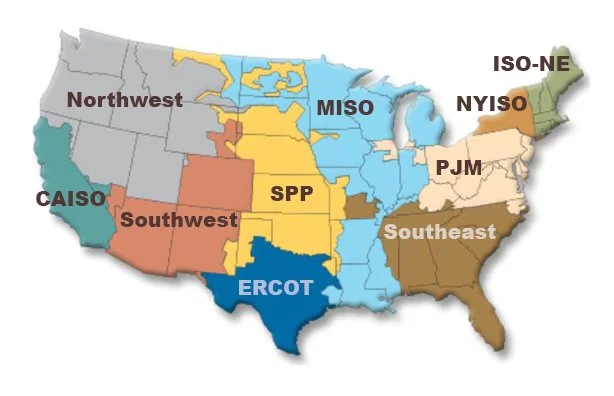
Wholesale Electricity Markets in the U.S.
Source: Electric Power Markets, National Overview, https://www.ferc.gov/electric-power-markets
In the United States, there are more than 9,000 power plants, nearly 160,000 miles of high-voltage power lines, and millions of low-voltage power lines and distribution transformers in the power grid. In order to efficiently and economically manage large power grids for their safe and reliable operations, wholesale and retail markets have been formed throughout the country. Several competitive wholesale markets in the United States are operated by the Independent System Operators (ISOs) or Regional Transmission Organizations (RTOs), such as Midcontinent Independent System Operator (MISO), California ISO (CAISO), Electric Reliability Council of Texas (ERCOT), New York ISO, New England ISO, and PJM Interconnection (PJM).
Market Settlements and Prices
Since the supply and demand of the electricity in the power system must be matched in real time, a two-settlement system including a day-ahead (DA) market and a real-time (RT) market is designed and operated by RTOs and ISOs. The two-settlement system can better arrange the generating resources to meet the anticipated and instantaneous power demands and determine the financial charges and credits to the market participants.
In the DA market, the demand bids and supply offers submitted by the market participants are used to determine an economic dispatch and calculate the next-day hourly locational marginal prices (LMPs), also called DA LMPs. As the instantaneous generation and load always deviate from the DA scheduled, the RT balancing of supply and demand is performed by RTOs and ISOs in the RT market and RT LMPs are calculated simultaneously based on the actual operating conditions and economic dispatch.
Given the demand bids and supply offers, the LMPs can be obtained via the dispatch optimization programs which makes the system demands be served safely and reliably at the least cost. The LMPs are combined with three pricing components: system energy price, transmission congestion cost, and marginal loss cost. These components make the LMP reflect the marginal cost of delivering an additional unit of energy to a specific location, such as a city, a power plant, and an aggregated load zone, in the power system.

